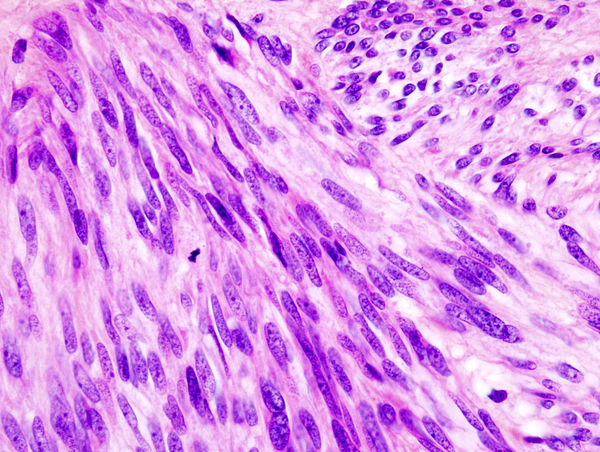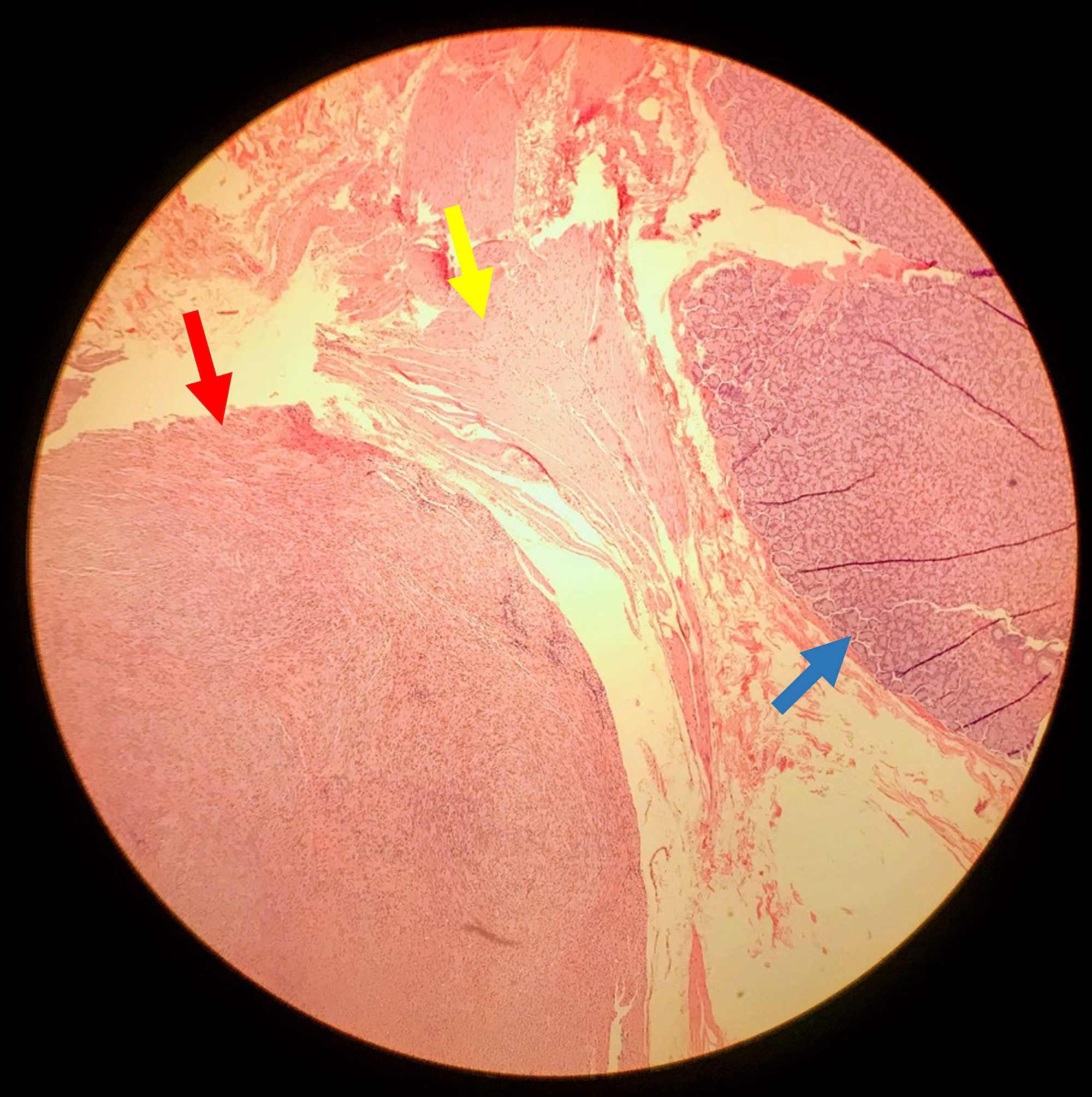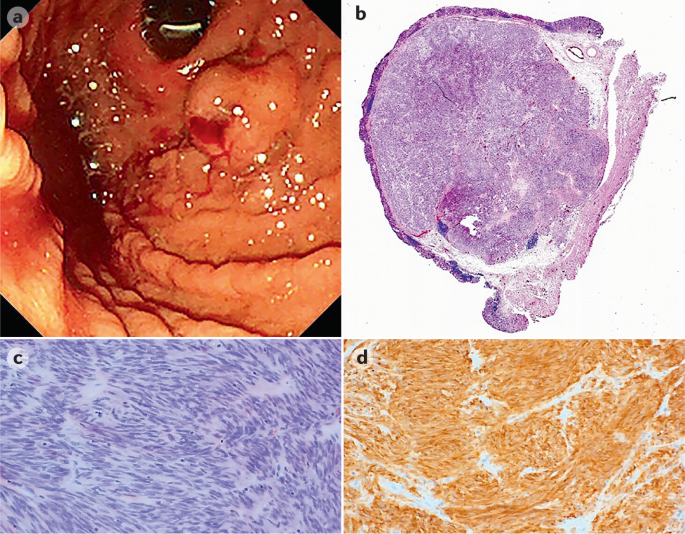Your Gastrointestinal stromal tumor spindle cell type images are ready in this website. Gastrointestinal stromal tumor spindle cell type are a topic that is being searched for and liked by netizens now. You can Get the Gastrointestinal stromal tumor spindle cell type files here. Download all royalty-free images.
If you’re searching for gastrointestinal stromal tumor spindle cell type pictures information connected with to the gastrointestinal stromal tumor spindle cell type keyword, you have come to the right blog. Our site always provides you with suggestions for viewing the highest quality video and image content, please kindly surf and locate more informative video content and graphics that match your interests.
Gastrointestinal Stromal Tumor Spindle Cell Type. A gastrointestinal stromal tumor GIST is a type of tumor that occurs in the gastrointestinal tract most commonly in the stomach or small intestine. The tumor is composed of mixture of both types hematoxylin and eosin staining original magnification x400. Digestive System Tumours Medicine 5th Edition 2019 Spindle. Overall about 70 of GISTs are composed of spindle cells which are long and thin in shape and sometimes described as fusiform.
 Gastrointestinal Stromal Tumor Wikiwand From wikiwand.com
Gastrointestinal Stromal Tumor Wikiwand From wikiwand.com
To our knowledge no imaging features have been described in immunostochemically confirmed canine GISTs. Elongated nuclei with inconspicuous nucleoli. Gastrointestinal stromal tumors GIST appear to originate from interstitial cells of Cajal ICC or their stem cell-like precursors12 ICC are pacemaker-like intermediates between the GI autonomic nervous system and smooth muscle cells regulating GI motility and autonomic nerve function34 KIT-positive and KIT-dependent ICC are located around the myenteric. To understand GISTs it helps to know something about the structure and function of the GI tract. They receive messages signals from the nervous system to make muscles of the GI tract tighten contract and relax expand. Mixture of both the patterns has been reported as well.
Gastrointestinal stromal tumors.
The most common site was the stomach 645. Necropsy confirmed ethylene glycol intoxication and the incidental finding of a neoplastic intestinal mass was diagnosed as spindle cell sarcoma. The tumor is composed of fusiform spindle cells with a fascicular growth pattern. A Spindle cell type. A gastrointestinal stromal tumor composed of neoplastic spindle cells. Immunohistochemical staining showed strong diffuse positivity for CD117 smooth muscle actin and S-100 indicating the final diagnosis of a spindle cell type gastrointestinal stromal tumor GIST.
 Source: thelancet.com
Source: thelancet.com
Digestive System Tumours Medicine 5th Edition 2019 Spindle. Bland spindle cells with faintly eosinophilic cytoplasm in a syncytial pattern. Spindle 70 epithelioid 20 mixed 10 WHO Classification of Tumours Editorial Board. Some of the tumors have neural appearance also. Preoperative imaging showed a huge submucosal tumor in the lower thoracic and abdominal.
Source: encrypted-tbn0.gstatic.com
To understand GISTs it helps to know something about the structure and function of the GI tract. Histomorphologically GISTs can be composed of thin elongated cells classified as spindle cell type or tumors which are dominated by epithelial appearing cells and are termed as epithelioid type. Approximately 20 of the cases are of epithelioid histologic variant and. They have characteristics of both smooth muscle cells and nerve cells. Gastrointestinal stromal tumours GISTs start in special cells of the gastrointestinal GI tract called interstitial cells of Cajal.
 Source: researchgate.net
Source: researchgate.net
A gastrointestinal stromal tumor GIST is a type of tumor that occurs in the gastrointestinal tract most commonly in the stomach or small intestine. CD117 may be negative in GISTs owing to either limited tumor sampling or rarely 5 a unique subset of CD117-negative GISTs that typically show an epithelioid morphology and are more likely to. Necropsy confirmed ethylene glycol intoxication and the incidental finding of a neoplastic intestinal mass was diagnosed as spindle cell sarcoma. Gastrointestinal stromal tumor is a disease in which abnormal cells form in the tissues of the gastrointestinal tract. The tumor is composed of large round or polygonal cells with abundant often eosinophilic or clear cytoplasm.
 Source: uofmhealth.org
Source: uofmhealth.org
KIT and PDGFRA mutations account for 8590 of GISTs. This report describes a 63-year-old female diagnosed with mixed spindleepithelioid cell GIST of the esophagus. Subsequent genetic studies have led to the. Necropsy confirmed ethylene glycol intoxication and the incidental finding of a neoplastic intestinal mass was diagnosed as spindle cell sarcoma. Gastrointestinal stromal tumor GIST Gastrointestinal stromal tumors GISTs may be defined as morphologically spindle cell epithelioid or occasionally pleomorphic mesenchymal tumours of the gastrointestinal tract that usually express the KIT protein and harbour mutation of a gene that encodes for a type III receptor tyrosine kinase.
 Source: commons.wikimedia.org
Source: commons.wikimedia.org
The tumor is composed of fusiform spindle cells with a fascicular growth pattern. Gastrointestinal stromal tumours GISTs start in special cells of the gastrointestinal GI tract called interstitial cells of Cajal. Histologic types were spindle cell type 75 mixed spindled-epithelioid type 171 and epithelioid type 79. Preoperative imaging showed a huge submucosal tumor in the lower thoracic and abdominal. The most common presentation was gastrointestinal bleeding 397.
 Source: researchgate.net
Source: researchgate.net
Tumor size ranged from 06 to 255 cm average 878 cm. Histologic types were spindle cell type 75 mixed spindled-epithelioid type 171 and epithelioid type 79. Gastrointestinal stromal tumors GIST appear to originate from interstitial cells of Cajal ICC or their stem cell-like precursors12 ICC are pacemaker-like intermediates between the GI autonomic nervous system and smooth muscle cells regulating GI motility and autonomic nerve function34 KIT-positive and KIT-dependent ICC are located around the myenteric. Gastrointestinal stromal tumors GISTs are uncommon cancers that start in special cells in the wall of the gastrointestinal GI tract also known as the digestive tract. Most tumors are of spindle cell type.
 Source: cureus.com
Source: cureus.com
Fewer than 1 of gastrointestinal stromal tumors GISTs are of the esophagus. KEY DIAGNOSTIC POINTS Gastrointestinal Stromal Tumors. Gastrointestinal stromal tumors. They receive messages signals from the nervous system to make muscles of the GI tract tighten contract and relax expand. The tumor is composed of fusiform spindle cells with a fascicular growth pattern.
 Source: nature.com
Source: nature.com
They receive messages signals from the nervous system to make muscles of the GI tract tighten contract and relax expand. Spindle 70 epithelioid 20 mixed 10 WHO Classification of Tumours Editorial Board. A Spindle cell type. Gastrointestinal stromal tumor GIST spindle cell type 30 cm grade 1 see synoptic report for risk stratification as well as biomarker report Differential diagnosis Low. The discovery of activated KIT mutations in gastrointestinal GI stromal tumors GISTs in 1998 triggered a sea change in our understanding of these tumors and has ushered in a new paradigm for the use of molecular genetic diagnostics to guide targeted therapies.
Source: researchgate.net
Gastrointestinal stromal tumours GISTs start in special cells of the gastrointestinal GI tract called interstitial cells of Cajal. Gastrointestinal stromal tumors GISTs are uncommon cancers that start in special cells in the wall of the gastrointestinal GI tract also known as the digestive tract. Gastrointestinal stromal tumor is a disease in which abnormal cells form in the tissues of the gastrointestinal tract. A gastric stromal tumor of spindle cell type is composed of uniform eosinophilic cells arranged in short fascicles A. Bland spindle cells with faintly eosinophilic cytoplasm in a syncytial pattern.
 Source: semanticscholar.org
Source: semanticscholar.org
To our knowledge no imaging features have been described in immunostochemically confirmed canine GISTs. Gastrointestinal stromal tumor GIST spindle cell type 30 cm grade 1 see synoptic report for risk stratification as well as biomarker report Differential diagnosis Low. This type of tumor is thought to grow from specialized cells found in the gastrointestinal tract called interstitial cells of Cajal ICCs or precursors to these cells. GISTs can be pathologically classified into 3 types. Tumor size ranged from 06 to 255 cm average 878 cm.
 Source: commons.wikimedia.org
Source: commons.wikimedia.org
KEY DIAGNOSTIC POINTS Gastrointestinal Stromal Tumors. CD117 may be negative in GISTs owing to either limited tumor sampling or rarely 5 a unique subset of CD117-negative GISTs that typically show an epithelioid morphology and are more likely to. To our knowledge no imaging features have been described in immunostochemically confirmed canine GISTs. Gastrointestinal stromal tumors. The most common site was the stomach 645.
 Source: researchgate.net
Source: researchgate.net
Gastrointestinal stromal tumours GISTs start in special cells of the gastrointestinal GI tract called interstitial cells of Cajal. CD117 is typically expressed when mutation of the c-kit gene results in elevated KIT protein a sensitive marker for GIST. Gastrointestinal stromal tumors GISTs are uncommon cancers that start in special cells in the wall of the gastrointestinal GI tract also known as the digestive tract. Most tumors are of spindle cell type. Preoperative imaging showed a huge submucosal tumor in the lower thoracic and abdominal.
Source: journals.plos.org
3 morphologic types. A gastrointestinal stromal tumor composed of neoplastic spindle cells. This report describes a 63-year-old female diagnosed with mixed spindleepithelioid cell GIST of the esophagus. To our knowledge no imaging features have been described in immunostochemically confirmed canine GISTs. The tumor is composed of mixture of both types hematoxylin and eosin staining original magnification x400.
 Source: researchgate.net
Source: researchgate.net
To understand GISTs it helps to know something about the structure and function of the GI tract. Overall about 70 of GISTs are composed of spindle cells which are long and thin in shape and sometimes described as fusiform. Genetic factors can increase the risk of having a gastrointestinal stromal tumor. Gastrointestinal stromal tumors GISTs are uncommon cancers that start in special cells in the wall of the gastrointestinal GI tract also known as the digestive tract. Canine gastrointestinal stromal tumors GISTs are a recent subtype of gastrointestinal spindle cell tumor recognized with the increasing use of immunohistochemistry.
 Source: researchgate.net
Source: researchgate.net
Gastrointestinal stromal tumor GIST is the most common primary mesenchymal tumor of the gastrointestinal tract GIT. Tumor size ranged from 06 to 255 cm average 878 cm. Fewer than 1 of gastrointestinal stromal tumors GISTs are of the esophagus. CD117 is typically expressed when mutation of the c-kit gene results in elevated KIT protein a sensitive marker for GIST. Elongated nuclei with inconspicuous nucleoli.
 Source: cancer.org
Source: cancer.org
Necropsy confirmed ethylene glycol intoxication and the incidental finding of a neoplastic intestinal mass was diagnosed as spindle cell sarcoma. The most common site was the stomach 645. 20 are composed of epithelioid cells which are round or polygonal in shape and 10 contain a mixture of these two cell types. A gastrointestinal stromal tumor composed of neoplastic spindle cells. Gastrointestinal stromal tumor is a disease in which abnormal cells form in the tissues of the gastrointestinal tract.
 Source: wjgnet.com
Source: wjgnet.com
20 are composed of epithelioid cells which are round or polygonal in shape and 10 contain a mixture of these two cell types. The discovery of activated KIT mutations in gastrointestinal GI stromal tumors GISTs in 1998 triggered a sea change in our understanding of these tumors and has ushered in a new paradigm for the use of molecular genetic diagnostics to guide targeted therapies. Histologic types were spindle cell type 75 mixed spindled-epithelioid type 171 and epithelioid type 79. Gastrointestinal stromal tumours GISTs start in special cells of the gastrointestinal GI tract called interstitial cells of Cajal. Most tumors are of spindle cell type.
 Source: consultant360.com
Source: consultant360.com
A gastric stromal tumor of spindle cell type is composed of uniform eosinophilic cells arranged in short fascicles A. Gastrointestinal stromal tumors GIST appear to originate from interstitial cells of Cajal ICC or their stem cell-like precursors12 ICC are pacemaker-like intermediates between the GI autonomic nervous system and smooth muscle cells regulating GI motility and autonomic nerve function34 KIT-positive and KIT-dependent ICC are located around the myenteric. This type of tumor is thought to grow from specialized cells found in the gastrointestinal tract called interstitial cells of Cajal ICCs or precursors to these cells. Gastrointestinal stromal tumors GISTs are uncommon cancers that start in special cells in the wall of the gastrointestinal GI tract also known as the digestive tract. A small intestinal stromal tumor of epithelioid type shows a nested paraganglioma-like appearance B.
This site is an open community for users to share their favorite wallpapers on the internet, all images or pictures in this website are for personal wallpaper use only, it is stricly prohibited to use this wallpaper for commercial purposes, if you are the author and find this image is shared without your permission, please kindly raise a DMCA report to Us.
If you find this site beneficial, please support us by sharing this posts to your favorite social media accounts like Facebook, Instagram and so on or you can also bookmark this blog page with the title gastrointestinal stromal tumor spindle cell type by using Ctrl + D for devices a laptop with a Windows operating system or Command + D for laptops with an Apple operating system. If you use a smartphone, you can also use the drawer menu of the browser you are using. Whether it’s a Windows, Mac, iOS or Android operating system, you will still be able to bookmark this website.







